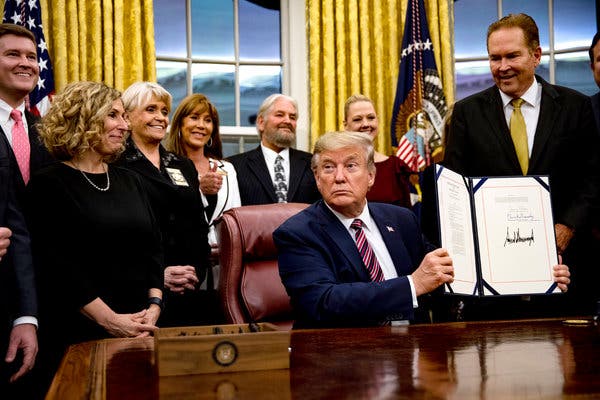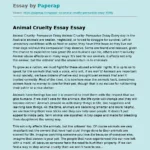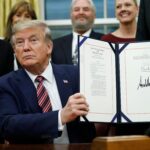In the arena of animal rights, 2019 heralded a significant milestone when President Trump signed a federal bill aimed at combating animal cruelty. This legislative action raised hopes among animal advocates, who believed it would signify a turning point in the fight against the cruelty endured by countless animals. However, underlying this legislative triumph are insinuations and perplexities that beg scrutiny. Is there a pattern emerging that suggests that this administration, rather than exclusively advancing animal welfare, is also crafting a narrative that conceals the disturbing realities of animal abuse? Investigating these claims reveals a perplexing interplay of politics and compassion.
The federal legislation, known as the Preventing Animal Cruelty and Torture (PACT) Act, indeed means to establish felonies for any acts of animal cruelty. Premiering as a historic achievement, it was received with gusto by animal rights activists. Yet, juxtaposed against this triumph are scattered reports and anecdotes indicating inconsistencies in official stances concerning animal welfare. These conflicting narratives prompt deeper inquiries into the authenticity of governmental commitment to the cause of animal protection.
Before delving into the implications of alleged cover-ups, it is crucial to explore the broader context of animal cruelty within the United States. The country grapples with a patchwork of laws governing animal rights, resulting in a disparity in protection across state boundaries. Certain states are lauded for their stringent animal welfare regulations, while others remain pitifully lax. Such inconsistencies foster an environment rife for exploitation. Amidst this paradox stands the federal government—a beacon of hope yet capable of stymying progress.
Animal advocacy groups often find themselves mired in discussions of the systemic issues that contribute to the pervasiveness of cruelty. The American Society for the Prevention of Cruelty to Animals (ASPCA) and various grassroots organizations tirelessly dissect reports of abuse. However, one questions whether the administration’s endorsement of animal welfare is a genuine effort or merely a veneer over a deeper malaise. With fleeting legislative victories juxtaposing horrific incidents in laboratories, puppy mills, and industrial farming, one can argue that the narrative crafted by politicians may be prone to oversimplification.
Critically, public perception plays an indispensable role in this debate. Animal cruelty cases, particularly those that attract media attention, often elicit immediate outrage. Yet, the temporal nature of these sentiments can conveniently ebb, allowing systemic abuses to persist unnoticed. To exacerbate the situation, whistleblowers who dare to expose animal mistreatment within corporate structures or government facilities frequently encounter extensive legal and social repercussions. This culture of silence can be perceived as a subtle yet insidious form of cover-up, where the reality of abuse is methodically obscured under layers of bureaucracy and corporate allegiance.
The aversion towards transparency begs the question of accountability. The PACT Act stands as a legal edifice erected to symbolize progress, yet what of the cases that lie in the shadows? Accusations of inadequate investigations into animal cruelty complaints languish under the weight of bureaucratic inertia. The reliance on state enforcement agents, often overwhelmed by the sheer volume of animal-related complaints, poses a significant hurdle. As documented cases remain unaddressed, a veil enveloping these incidents persists, leading many to posit that the administration may harbor a vested interest in fostering an illusion of competence in animal welfare.
Moreover, one must consider the political ramifications of virulent animal cruelty scandals that could implicate prominent industries. From factory farming to vivisection, industries entwined with economic power possess the means to exert influence over political agendas. This raises an unsettling specter of prioritizing corporate interests over animal welfare, prompting questions regarding the true motivations of those in power. When public figures are predisposed to roundly denounce individual cruelty while failing to hold entire industries accountable, it foreshadows a broader issue of selective outrage. There is an oft-perpetuated notion that the robust lobby of agribusiness cultivates relationships with policymakers, thereby perpetuating the cycles of cruelty within unchecked systems.
Conspiracy theories may abound in the discourse surrounding animal cruelty, but calls for transparency and genuine reform should not be mistaken for paranoia. Those advocating for animal rights often encounter an uphill battle, fighting against entrenched beliefs and deeply rooted economic structures. The insatiable hunger for profit in the agribusiness sector juxtaposed against ethical considerations compels advocates to demand answers. Will the complexity of systemic abuse be acknowledged? Or will it be shrouded beneath an air of legislative triumphs?
Fundamentally, the core issue extends beyond any singular political figure; it encompasses the broader societal context in which animal welfare is often circumvented for convenience. The dynamic between legislation, public perception, and maintenance of status quo constitutes a fertile ground for scrutiny. While the signing of the PACT Act invoked enthusiasm, it merely serves as a starting point rather than an endpoint. Challenging the status quo necessitates the cultivation of vigilance and sustained advocacy to ensure claims of reform do not overshadow the grim realities of ongoing animal abuse.
As we unravel the web of policies, perceptions, and potential cover-ups tied to animal cruelty, one fact remains irrefutable: real change requires accountability, systemic reform, and the unyielding voice of advocates. The welfare of countless animals relies upon the collective commitment to challenging narratives that prioritize image over integrity. Forging a path away from obscurity means embracing uncomfortable truths, demanding unwavering transparency, and holding all actors responsible. The quest for justice for animals necessitates diligence and resilience, ensuring their plight is never relegated to mere footnotes in political discourse.









